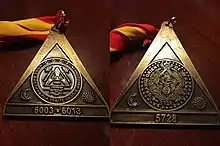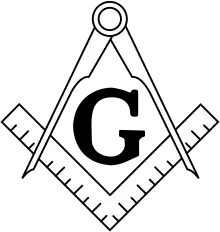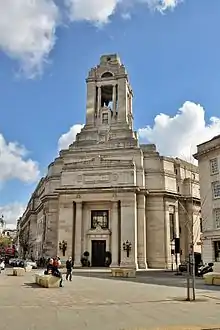Continental Freemasonry
Continental Freemasonry, also known as Liberal Freemasonry,[1] Latin Freemasonry[2][3] and Adogmatic Freemasonry,[4] includes the Masonic lodges, primarily on the continent of Europe, that recognise the Grand Orient de France (GOdF) or belong to CLIPSAS, SIMPA, TRACIA, CIMAS, COMAM, CATENA, GLUA or any of various other international organizations of Liberal, i.e. Continental Freemasonry. The larger number of Freemasons, most of whom live in the USA, where Regular Freemasonry holds a virtual monopoly, belong to lodges that recognise the United Grand Lodge of England and do not recognise Continental Freemasons, regarding them as "irregular".[5][6]
| Part of a series on |
| Freemasonry |
|---|
 |
Two branches of Freemasonry
Freemasonry has two branches "not in mutual regular amity";[7]
- the Anglo/American "Regular" tradition of jurisdictions, typified by the United Grand Lodge of England (UGLE), and the various Grand Lodges in the United States.
- the European "Continental" tradition of jurisdictions, typified by GODF, with varying and shifting amity.
In Latin American countries, Continental Europe and much of Africa the GODF-style or European Continental Freemasonry predominates,[8] although those nations may also have smaller Grand Lodges and Grand Orients that are part of the “Regular” tradition.
History of the schism
There are several reasons for the schism in Freemasonry, and why it persists. The first instance of derecognition occurred in the United States shortly after the American Civil War. In 1869, the Grand Orient de France (GODF) recognized a Masonic group in Louisiana which was not recognized by the Grand Lodge of Louisiana (GLL). This was seen by GLL as an invasion of its jurisdiction, and it withdrew its recognition of GODF. At the request of GLL, several other American Grand Lodges also withdrew recognition.[9] There is evidence that racial motivations may have played a part in this derecognition. The GODF had recently passed a resolution stating that "neither color, race, nor religion should disqualify a man for initiation"[10] and the Grand Lodge of Louisiana strictly excluded blacks and those of mixed race. The initial schism was not unanimous in the US. Many American Grand Lodges continued to recognize the GODF well into the 20th century.[11]
1877 schism
The schism widened in 1877 when the GODF changed its constitutions to allow for complete religious "Laïcité". While the Anglo-American tradition had long required candidates to acknowledge a belief in deity, the GODF removed that requirement, stating that Laïcité "imposes that all men are given, without distinction of class, origin or denomination, the means to be themselves, to have the freedom of choice, to be responsible for their own maturity and masters of their destiny."[12][13] In sum, the GODF would admit atheists, while the lodges in the Anglo-American tradition would not. The United Grand Lodge of England then withdrew its recognition, and declared the GODF to be "irregular." As other jurisdictions tended to follow the lead of either GODF or UGLE, the schism widened.
Background on the belief in Deity
There is some debate about when Anglo-American Freemasonry began requiring a belief in Deity. It may have dated from the earliest days of Freemasonry: the Regius Manuscript, the oldest known Masonic document dating from 1425–50, states that a Mason "must love well God and holy church always." James Anderson's 1723 Constitutions state that "A Mason is oblig'd by his Tenure, to obey the moral Law, and if he rightly understands the Art, he will never be a stupid Atheist, nor an irreligious Libertine."
The GODF required belief in God from 1849 until 1877, and then reversed its position.[10][14]
The difference was not limited to the requirement in belief. Following the 1877 changes, the Grand Orient also removed all references to the Grand Architect of the Universe from its rite, and removed the Volume of the Sacred Law (which in France was the Bible) from its ritual. These elements had been present in French freemasonry before 1849.
Political discussion in the lodges
Another difference between Continental and Anglo-American Freemasonry is that political discussion is allowed in Lodges following the Continental tradition, while it is strictly banned in the Anglo-American tradition.
Relationship with the Catholic Church
Continental Freemasonry has been concentrated in traditionally Catholic countries and has been seen by Catholic critics as an outlet for anti-Catholic disaffection.[15] Many particularly anti-clerical regimes in traditionally Catholic countries were perceived as having strong Masonic connections.[2]
The 1913 Catholic Encyclopedia credited Freemasonry for the French Revolution and its persecution of the Church, citing a claim made in a document from the Grand Orient de France.[16] The Encyclopedia saw Freemasonry as the primary force of French anti-clericalism from 1877 onwards, again citing official documents of French Masonry to support its claim.[17] According to one historian, Masonic hostility continued into the early twentieth century with the Affaire Des Fiches[18] and, according to the old Catholic Encyclopedia, the 1905 French law on the Separation of the Churches and the State[19] can be credited to the Grand Orient de France, based on Masonic documents.
In Italy, the Church linked the anticlerical and nationalist secret society, the Carbonari, to Freemasonry[20] and blamed the anticlerical direction of Italian Unification, or Risorgimento, on Freemasonry. Into the 1890s the Church would justify its calls for Catholics to avoid dealings with the Italian state with a reference to the state's supposed "Masonic" nature.[21]
Mexican Freemasonry was also seen as following the pattern of Continental Freemasonry in other Latin-speaking countries, viewed as becoming more anti-clerical during the nineteenth century, particularly because they adopted the Scottish Rite degree system created by Albert Pike, which the Catholic Church saw as anti-clerical.[22]
Even as late as 2005, the president of Spain's Union of Catholic Professional Fraternities blamed the anti-clerical measures of the Socialist government on a "tremendous crusade by Masonry against the Church."[23]
Freemasons attached to the more mainstream branch of Freemasonry, affiliated with the United Grand Lodge of England and the 51 US Grand Lodges, have often claimed that the anticlericalism of the Continental Branch of Freemasonry is a "deviation" from proper Freemasonry.[24][25]
Continental Freemasonry across the world
Continental style Lodges exist in most regions of the world. Throughout Continental Europe, Latin America, most of the Caribbean and most of Africa, they are the predominant tradition of Freemasonry, while in the United States of America, the British Commonwealth, and those nations colonized by these powers they are virtually non-existent.
Latin America and the Caribbean
Throughout Latin America and the Caribbean, both Continental and Anglo-American, conservative jurisdictions exist but Continental style Masonic Bodies predominate. In Brazil, for example, the largest and oldest Masonic body, the Grande Oriente do Brasil is recognised by Anglo-American jurisdictions. Nevertheless, when its membership numbers are compared to the members of all of the Continental style Masonic Bodies, it remains a minority.[26]
In many Latin American countries, the Masonic split has mirrored political divisions. Rivalry between two factions in Mexican Freemasonry is said to have contributed to the Mexican civil war.[27]
Continental Europe

France
Continental style Freemasonry originated in France and its members make up the overwhelming majority of Freemasons in the nation. The Grand Orient de France is the largest Masonic jurisdiction, with the Grande Loge de France (also within the Continental tradition) second in membership. The third largest Masonic body is the Anglo-American style Grande Loge Nationale Française. The International Order of Freemasonry for Men and Women Le Droit Humain founded in 1893 has 32,000 members in more than 60 countries.[28]
Other European countries
Continental style Freemasonry is prevalent in most of the continent (as its name suggests), although there are smaller numbers of members following the Anglo-American tradition in those nations also.[8][29] Liberal Continental Freemasonry is present in the majority in most European countries. However, in Germanic states, Anglo-American and Swedish Rite traditions predominate.
North America
Although some Continental style organizations exist in the United States of America, they are a tiny minority there and have substantially larger (but still minor) numbers in Canada. In Mexico, however, Continental Freemasonry dominates. These Grand Lodges, Grand Orients and Masonic Orders usually belong to international organizations such as CLIPSAS, SIMPA, CIMAS, COMAM, GLUA, TRACIA and others.
Within the United States of America there are scattered Masonic Orders and Grand Lodges, such as the George Washington Union (GWU),[30] the Omega Grand Lodge of the State of New York,[31] and Le Droit Humain (LDH),[32] that belong to the Continental or Progressive Universal Tradition. The Women's Grand Lodge Of Belgium (GLFB or WGLB),[33] and the Feminine Grand Lodge of France[34] also have liberal lodges in North America.
Africa
Continental Freemasonry holds the majority in most nations, especially in French speaking areas. It tends to originate from the French and Belgian former colonists. African leaders such as Omar Bongo of Gabon and Pascal Lissouba of the Republic of the Congo belong to Masonic lodges allied with Continental Freemasonry.[35]
Notes
- "This new concept of Freemasonry – of absolute freedom of conscience... born in the "Convent" (Annual General Meeting) of 1877 and gave birth to a new form of practise in Freemasonry which is called Liberal Freemasonry." Grand Orient de France. archived 23 January 2010.
- "So far does this militant atheism of 'Latin Freemasonry' in France go," (Johnston 1918, p. 71).
- "Nevertheless, the Vatican, with its long experience of Latin Freemasonry, has not altered its opposition to and disapproval of all brands of Freemasonry" (Glazier & Hellwig 2005, p. 330).
- "which are convinced that the social, moral and intellectual liberation of men and women will be the result of an unending struggle against dogmatic limitations, sectarian forces and ideologies that violate adogmatic freemasonry;" from the Belgian Freemason website. archived 17 July, 2011.
- Hodapp 2011.
- Hodapp 2009.
- Bauer 2002.
- Pieyns, René, Het rijke maçonnieke leven, 3. De universele vrijmetselarij, Fonds Marcel Hofmans, Brussels, 2001, p. 12-26
- U.S. Recognition of French Grand Lodges in the 1900s Archived 10 April 2006 at the Wayback Machine Paul Bessel, published in Heredom: The Transactions of the Scottish Rite Research Society – volume 5, 1996, pages 221–244
- Denslow, Ray V. (1954), Freemasonry in the Eastern Hemisphere, p. 170, ISBN 9781428639881
- U.S. Recognition of French Grand Lodges in the 1900s Archived 10 April 2006 at the Wayback Machine, Paul Bessel, published in Heredom: The Transactions of the Scottish Rite Research Society – volume 5, 1996, pages 221–244
- Grand Orient of France: Laïcité Archived 14 November 2008 at the Wayback Machine
- Can Freemasonry be Secular? Archived 1 December 2008 at the Wayback Machine
- Iowa Proceedings 1918, pp. 25–29.
- "Everyone knows that the Grand Orient Lodges of Europe and Latin America have been anti-clerical from the start. For the Congregation for the Doctrine of the Faith to advise Catholics against joining these Grand Orient Lodges would be like the National Association for the Advancement of Colored People advising blacks against applying for membership in the Ku Klux Klan", William Whalen, The Pastoral Problem of Masonic Membership
- "Masonry, which prepared the Revolution of 1789, has the duty to continue its work" (Gruber 1910, VII. Outer Work footnote 163 cites: the Circular of the Grand Orient of France, 2 April 1889,
- "French Masonry and above all the Grand Orient of France has displayed the most systematic activity as the dominating political element in the French "Kulturkampf" since 1877" (Gruber 1910, VII Outer work).
- Franklin 2006, p. 9 (footnote 26) cites Larkin, Maurice, Church and State after the Dreyfus Affair, pp. 138–141: "Freemasonry in France", Austral Light, 6: 164–172, 241–250, 1905
- "In truth all the 'anti-clerical' Masonic reforms carried out in France since 1877, such as the secularization of education, measures against private Christian schools and charitable establishments, the suppression of the religious orders and the spoliation of the Church, professedly culminate in an anti-Christian and irreligious reorganization of human society, not only in France but throughout the world" (Gruber 1910, VII Outer work).
"From the fall of the MacMahon government in 1877 to the start of World War II, Masonic politicians controlled the French government. They passed anticlerical laws designed to restrict the Church's influence, especially in education" (New Catholic Encyclopedia 1967, p. 135). - "It also links Freemasonry with the Society of the Carbonari, known as the "Charcoal Burners", who at that time were active in Italy and were believed to be a revolutionary group" (McInvale, Reid (18 June 2013), Roman Catholic Church Law Regarding Freemasonry, Texas Lodge of Research, retrieved 1 August 2013
- "Masonry has confiscated the inheritance of public charity; fill the void, then, with the treasure of private relief" (Pope Leo XIII (1999), Custodi di Quella Fede (Encyclical of Pope Leo XIII promulgated on 8 December 1892), Eternal Word Television Network, p. Para 18).
- "As the 19th Century went on, Mexican Masonry embraced the degree system authored by Albert Pike and grew ever more anticlerical, regardless of Rite" (Salinas E., Oscar J. (Senior Grand Warden-York/Mexico) (10 September 1999), Mexican Masonry – Politics & Religion, archived from the original on 15 June 2011)
- "The president of the Union of Catholic Professional Fraternities, Luis Labiano, said this week a "tremendous crusade by Masonry against the Church" exists in Spain." Spanish Catholic organization blames Masons for “tremendous crusade” against Church, 27 September 2004, Catholic News Agency. Retrieved 22 October 2011.
- 15. Are Freemasons anticlerical?, Regular Grand Lodge of Belgium
- Good Catholics Should Not be Masons Archived 29 January 2012 at the Wayback Machine, Fr Adrian Beck, Catholic Herald, 11 April 2009
- MIT Freemasonry webpage
- Whalen, William J., "Freemasonry", hosted at trosch.org. from New Catholic Encyclopedia, Vol. 6, pp.132–139. Retrieved 21 October 2011.
- Le Droit Humain official website https://ledroithumain.international/organization/?lang=en. Retrieved 14 June 2021.
{{cite web}}: Missing or empty|title=(help) - "The Regular Grand Lodge of Belgium". Archived from the original on 20 April 2013. Retrieved 12 October 2012.
- "George Washington Union". George Washington Union. Retrieved 16 December 2021.
- CLIPSAS member list Archived 25 May 2012 at archive.today
- The International Order of Freemasonry for Men and Women Le Droit Humain
- Grande Loge Féminine de Belgique and Montréal in Québec Archived 29 September 2007 at the Wayback Machine
- Feminine Grand Lodge of France Archived 28 October 2008 at the Wayback Machine
- Wauthier, Claude. Africa's Freemasons – A strange inheritance, Le Monde diplomatique, September 1997. Retrieved 15 August 2008.
References
- Bauer, Alain (Grand Master of the Grand Orient of France Sacramento) (27 July 2002), Address to the 2002 California Masonic Symposium, archived from the original on 7 January 2009
- New Catholic Encyclopedia, New York: McGraw-Hill, vol. 6, p. 135, 1967
{{citation}}: Missing or empty|title=(help) - Franklin, James (2006), "Freemasonry in Europe", Catholic Values and Australian Realities, Connor Court Publishing Pty Ltd, pp. 7–10, ISBN 9780975801543
- Glazier, Michael; Hellwig, Monika K., eds. (January 2005), The Modern Catholic Encyclopedia, Liturgical Press, p. 330, ISBN 0-8146-5219-0
- Gruber, Hermann (1910). . In Herbermann, Charles (ed.). Catholic Encyclopedia. Vol. 9. New York: Robert Appleton Company.
- Hodapp, Christopher (18 January 2011), More squabbles in the irregular world, Freemasonry for Dummies website
- Hodapp, Christopher (5 September 2009), Grand Orient of France Votes Against Women Members, Freemasonry for Dummies blog
- Johnston, Charles. (24 February 1918), "Caillaux's Secret Power Through French Masonry" (PDF), The New York Times Magazine: 71, retrieved 1 August 2013

